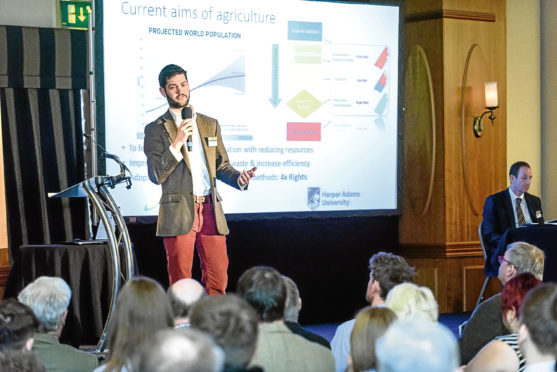The future of farming lies in swarms of small-scale robotic tractors and machinery, rather than high horsepower tractors with precision tools hitched on the back.
That was the message from Harper Adams University lecturer in agri-engineering, Kit Franklin, at the Farming Scotland Conference in Carnoustie.
The event, which was organised by EQ Chartered Accountants with support from Bell Ingram, Royal Bank of Scotland and Thorntons, was focused on innovations in farming.
Mr Franklin, who recently led a £200,000 project to sow, grow and harvest a crop of cereals using robotic technology, said the farming industry’s drive towards bigger, more powerful tractors was misguided.
“Big machines are not really any good for precision farming,” he told delegates.
Mr Franklin said big machines were also the cause of problems with soil health, compaction and the well-document yield plateau in the UK cereals sector.
He blamed the move towards larger machines on reduced labour on farms, limited time windows to carry out vital tasks, a sense of “one-upmanship” and the perception that bigger machines would solve compaction issues.
“Maybe we need to rethink that idea that more power is key,” said Mr Franklin.
“Around 80% of the energy you put into doing tillage is simply undoing all the damage you have done.”
Looking to the future, Mr Franklin said automation on farms was only five years away.
He said the recent Hands Free Hectare project, which was funded by Innovate UK and run by Harper Adams University in conjunction with Precision Decisions, gave a glimpse of the way farms could be managed in the future. The project which proved that robots can sow, manage and harvest a crop, is set to be repeated again this year and Mr Franklin and his team hope to fine-tune the technology to make it run more smoothly.
Mr Franklin said the findings showed that cheaper precision farming technology was possible and that automation could work in a commercial scenario.
“We need to take away our 300-horsepower tractors off the soils because they are not doing anything good at all, and then put the driver in charge of some automated tractors,” said Mr Franklin.
The drive to improve soil health was backed by the Scottish Government’s agricultural sustainability champion John Kinnaird.
Mr Kinnaird said improved soil health could play a positive role in the absorption of greenhouse gas emissions. He said a 1% increase in organic matter per hectare meant 35tonnes of CO2 removed from the atmosphere.
